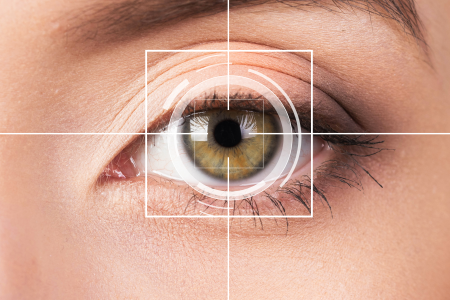Is your web page causing computer vision syndrome?
Reading on the screen is hard for a simple reason: Our eyes weren’t made to stare at little beige boxes all day.

When reading online, your readers face these special problems:
- Light. Reading online is like reading with a flashlight shining in your eyes. And you know what happens when you spend your day staring at a lightbulb.
- Blinking. People blink less often when reading online than when reading print. That’s a problem, because blinking is what keeps our eyes moist and relaxed. They also open their eyes wider when reading on the screen. That makes their tears evaporate faster and leads to dry eye.
- Scrolling. The human eye has a normal reflex called optokinetic nystagmus. That’s scientist talk for the way our eyes flit across the screen to follow scrolling type. That constant jumping up and down can wear your readers out, cause eyestrain and cause readers to feel a little seasick. (So you can cause readers to throw up from what you write online.)
The result?
Some 12 million Americans visit eye doctors each year because of computer-related problems, according to the American Optometric Association. That’s one out of every five people who come in for an eye exam.
Among the issues:
Computer vision syndrome
Some 50% to 90% of computer users suffer from eye strain, according to WebMD. No wonder computer vision syndrome is recognized by the American Optometric Association. It includes these symptoms:
- Sore or irritated eyes
- Trouble focusing
- Dry or watery eyes
- Blurred or double vision
- Sensitivity to light
- Shortsightedness
Eye strain
People who spend hours staring at a screen suffer chemical changes in their tears similar to folks with dry eye, according to a 2014 Japanese Dry Eye Society study. Symptoms include irritation, burning and blurred vision.
Screen-sightedness
Reading a blog post on an iPhone is like reading War and Peace through a keyhole — with a flashlight shining in your eyes.
No wonder, then, that screen reading causes — in addition to such symptoms as eyestrain and nausea — advancing myopia, aka shortsightedness.
Blame it on smartphones, says British eye surgeon David Allamby of Focus Clinics. He calls this epidemic “screen-sightedness.”
In fact, since smartphones were introduced in the 1990s, the number of people with this condition has increased by 35%, according to Allamby. By 2033, he predicts, half of all 30-year-olds will suffer from screen-sightedness.
A welcome site
Bottom line?
“I’ve had people come to our clinic saying they were going to quit their jobs because they couldn’t take it,” David Grisham, optometry professor at the University of California, told the San Francisco Chronicle.
Not exactly the purpose of your intranet, is it?
Don’t make your reader turn a blind eye to your message. When you write web content, get to the point faster, organize better, make it easier to read and more skimmable.

Leave a Reply